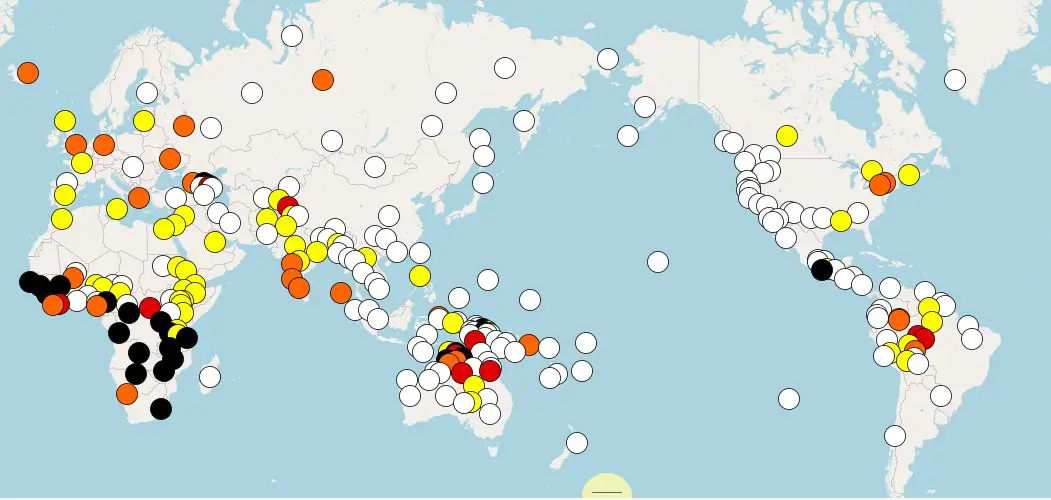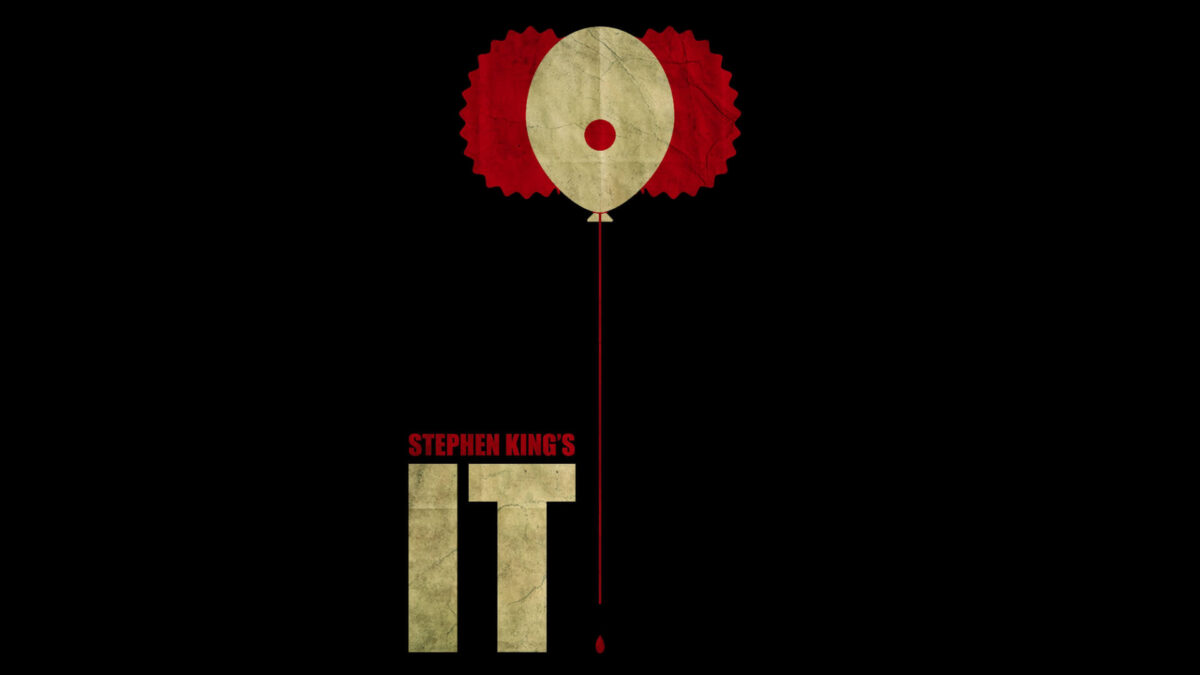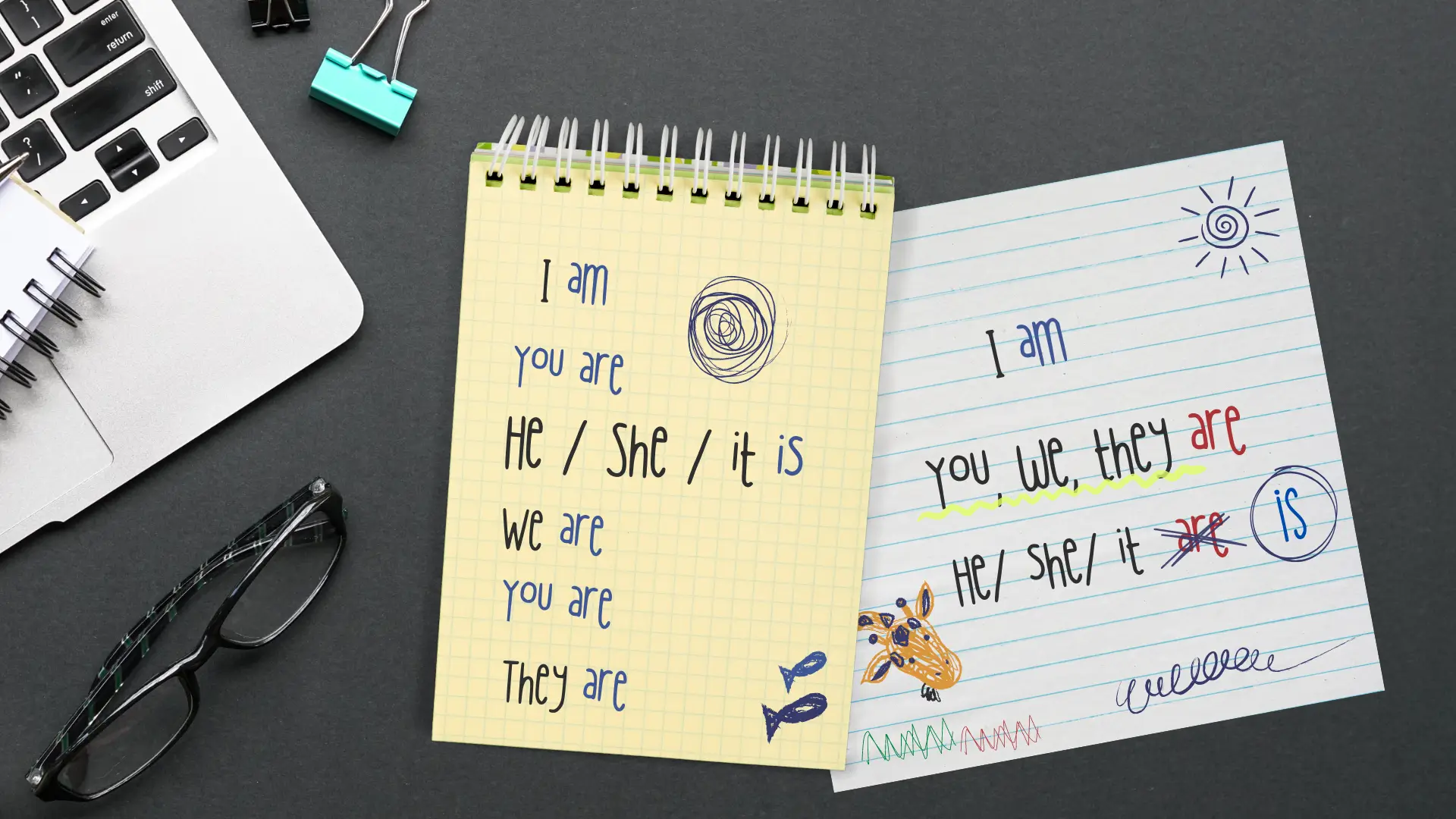Introduction
The Present Simple Tense and the verb to be are one of the first things beginner English learners come across as they start their journey, and as with anything new, there can be challenges. On this page, you will find explanations and examples of usage that will clear the picture.
The verb to be is one of the most important and widely used verbs – we use it to talk about things like facts and habits or describe people, things, and situations.
- That is a Golden retriever puppy. (fact)
- He is cute. (description & fact)
- He is serious and a little crossed. (state and maybe fact 😀)

Let’s look at the other ways we use the verb to be in English below and talk about some challenges it may present when conjugating it.
Check out the Table of Contents to move on to a section that interestest you the most.☺️
Possible challenges
Grammatical gender and the pronoun IT
English is a language “without” grammatical gender. Therefore, the concept of the pronoun it may be a bit difficult to understand for learners whose native languages do have grammatical gender.
However, many languages assign grammatical gender to objects as well, and that assignment of gender is usually not related to the noun’s real-world qualities. However, the grammatical gender affects the forms (specifically, endings) of other words in the sentence.
In some languages, it is easy to determine which nouns take feminine and which take masculine grammatical gender. For example, in Bulgarian masculine gender nouns usually end in a consonant, while feminine gender nouns end in the vowels -a or -я.
In Spanish, masculine nouns often end in -o/ -e, while feminine nouns end in -a. Examples below:
Bulgarian
| masculine ending | feminine ending |
| usually consonant | usually – а/ – я |
| стол, диван | кола, кутия |
| chair, sofa | car, box |
Spanish
| masculine ending | feminine ending |
| usually – o/ – e | usually – a |
| (el) cielo, (el) coche | (la) caja |
| sky, car | box |
As you can see, there is nothing masculine or feminine about the nouns above. 😀
| None | 145 | |
| Two | 50 | |
| Three | 26 | |
| Four | 12 | |
| Five or more | 24 |

The nightmare with IT
Because the pronoun IT stands for many things that can be either “he,” “she,” or “it” in languages with grammatical gender – the confusion may be overwhelming at first.
In Spanish, IT may refer to masculine singular nouns and feminine singular nouns. In Russian, IT may refer to “он” (masculine), “она” (feminine), or “оно“ (neuter). Here are some examples and comparisons:
| English | Russian |
| Where is the book? It’s on the table? | Где книга? Она на столе. |
| That is my favorite movie because it’s very dynamic. | Это мой любимый фильм, потому что он очень динамичный. |

The personal pronoun “you”
The personal pronoun “you” may also present some difficulties for new learners, especially for those whose native language is like Spanish or Russian (not only these two, of course), where there are two separate pronouns – one to use when addressing a single person and another one for when you talk to two or more people at the same time. There is also the issue of politeness, but we’ll mention it later. Here are two example conversations in Spanish and Bulgarian:
| English (sing.) | Spanish (sing.) |
| How are you? Good, thanks! And you? | ¿Cómo estás? Bien, ¡gracias! ¿Y tú? |
| English (pl.) | Spanish (pl.) |
| How are you? Good, thanks! And you? | ¿Cómo están? Bien, ¡gracias! ¿Y ustedes? |
| English (sing.) | Bulgarian (sing.) |
| How are you? Good, thanks! And you? | Как си? Добре, благодаря! А ти? |
| English (pl.) | Bulgarian (pl.) |
| How are you? Good, thanks! And you? | Как сте? Добре, благодаря! А вие? |
As can be seen above, some languages have different pronouns when addressing one or more people. That can take some practice for some learners to get used to.
Not to mention that, for example, in Bulgarian and Russian, there is a polite form of the pronoun “you” respectively, Вие, Вы. That form is used when addressing a stranger, a person in a higher position of authority, or when it is required to be polite, and, in writing, those pronouns are spelled with capital letters to indicate that. Because that is not the case in English, it can be confusing for many new learners in whose native languages it may be common to capitalize the polite form of “you” but never “I” unless at the beginning of a sentence.
The above are things you may need to take into account depending on your learner’s background.
Formation
Positive
The verb to be is easy to form. Unlike other languages, the one unique thing about it is – I AM. The rest can easily be grouped.

| I | + am |
| he/ she/ it | + is |
| you/ we/ they | + are |
- I am a student.
- You are kind.
- He is very tall.
- She is a doctor.
- It is cold outside.
- We are a family.
- You are here.
- They are together.
Let’s compare that, for example, to Finnish.
| English | Finnish |
| I am You are He/ She / It is We are You are They are | Minä olen Sina olet Hän/ Se on Me olemme Te olette He ovat |
As mentioned, the verb to be is easy to form. There is one small problem, and it has to do with the short forms that are formed using the apostrophe and are very commonly used. The apostrophe in English is used for various reasons and in many situations, but, in this case, it stands for the letter which is being omitted.
I am ➡️
You are ➡️
He/ She/ It is ➡️
We are ➡️
You are ➡️
They are ➡️
I’m
You’re
He‘s/ She’s / It’s
We’re
You’re
They’re
When shortened, the examples above look like this:
- I’m a student.
- You‘re kind.
- He’s very tall.
- She’s a doctor.
- It’s cold outside.
- We’re a family.
- You’re here.
- They’re together.
The short version of the verb to be is most commonly used, especially in spoken language.
The long and the short versions are different not only in writing but also in pronunciation. The meaning, of course, is the same. Here are some examples:
I am a student. ➡️ I’m a student.
We are a family. ➡️ We’re a family.
It is cold outside. ➡️ It’s cold outside.

Remember that time is money.
Benjamin Franklin, Advice to a Young Tradesman
Negative
The negative form of the verb to be is, you guessed it, even easier to form. All you need to do is add “not” at the end. For example, I am + not, and so on. (Depending on your learners’ native language and experience with other languages, the fact that not comes at the end may be strange, as in some languages it doesn’t, and they may be influenced to say I not am, instead of I am not. )
Let’s take the same comparison from before with the Finnish language.
| English | Finnish |
| I am not You are not He/ She / It is not We are not You are not They are not | Minä en ole Sina et ole Hän/ Se ei ole Me emme ole Te ette ole He eivät ole |
Short versions:
- I’m not
- You’re not/ you aren’t
- He’s not/ he isn’t
- She’s not/ she isn’t
- We’re not/ we aren’t
- You’re not/ you aren’t
- They’re not/ they aren’t
Positive questions
All you do to form positive questions with the verb to be is switch places. It doesn’t get any easier than that. 🤓
- I am
- You are
- He/ She/ It is
- We are
- You are
- They are
- Am I?
- Are you?
- Is he/ she/ it?
- Are we?
- Are you?
- Are they?
- She is hungry.
- Is she hungry?
- We are late.
- Are we late?
- They are siblings.
- Are they siblings?
Some languages have question words instead and follow different rules, like the example below with Bulgarian:
- Аз съм
- Ти си
- Той/ тя/ то е
- Ние сме
- Вие сте
- Те са
- Аз ли съм?
- Ти ли си?
- Той/ тя/ то ли е?
- Ние ли сме?
- Вие ли сте?
- Те ли са?
Others have a question word but also use reversed order like in English. Here is Finnish, for example, where the question article is attached to the conjugated verb, and the order is reversed:
- Minä olen
- Sinä olet
- Hän on
- Me olemme
- Te olette
- He ovat
- Olenko minä?
- Oletko sinä?
- Onko hän?
- Olemmeko me?
- Oletteko te?
- Ovatko he?
Negative questions
We established that to form positive questions, the verb and the pronoun switch places so that, for example, “you are” becomes “Are you?”. To make negative questions, we add not in between, but there is a catch… or two.
Firstly, not becomes n’t, and secondly, it is attached directly to the verb to be, like so:
- Are + n’t + you = Aren’t you?
- Is + n’t + he = Isn’t he?
So here are our negative questions:
- Aren’t I/ you/ we/ they?
- Isn’t he/ she/ it?
An outdated version of these negative questions would look the following way:
- Am I not?
- Are you not?
- Is he/ she/ not?
- Are we not?
- Are you not?
- Are they not?
The above are not common in modern communication. However, it is possible to see them in historical movies, TV series, and classic novels.
Example sentences with negative questions:
- Aren’t you happy?
- Isn’t she here?
- Aren’t they late?

Isn’t the weather lovely?
Usage
General truths and facts
The Present Simple Tense + the verb to be are used to talk about general truths and facts:
- The Sun is hot.
- The sky is blue.
- Paris is the capital of France.

No, the Earth is not flat.
Habits and routines
To talk about habits and routines in English using the verb to be, we often use adverbs of frequency. Those are words that describe how often something happens. Here are some examples of adverbs of frequency:
- always
- usually
- often
- sometimes
- never
Example sentences:
- She is usually busy in the evenings.
- The dog is always hungry in the morning.
- My sister is often late for school.
- John is rarely sick.
Other usages
The existence of something
- There is a new restaurant in town.
- There is a spider in the corner.
- There is a car parked outside.
Location & the relationship between objects
- My phone is in my pocket.
- The cat is under the chair.
- Her shoes are beside the door.
The identity/ state of a person, place, or thing
- That car is a hybrid.
- The table is dirty.
- I am happy.
How do you make the negative form of the verb to be in your native language?


